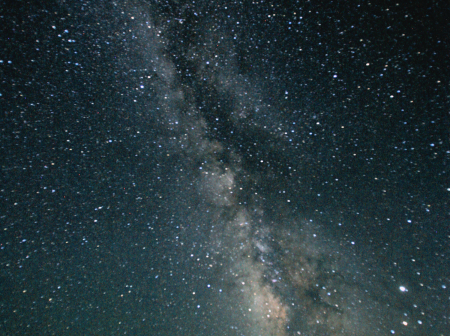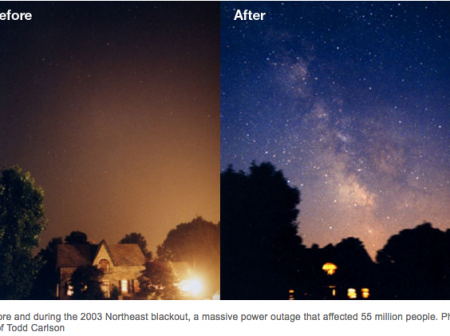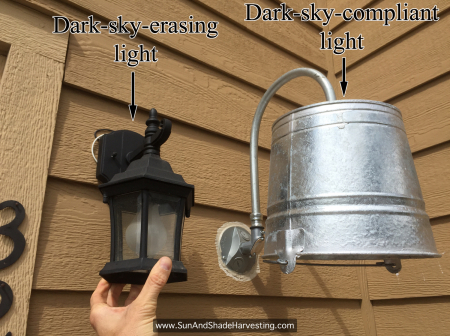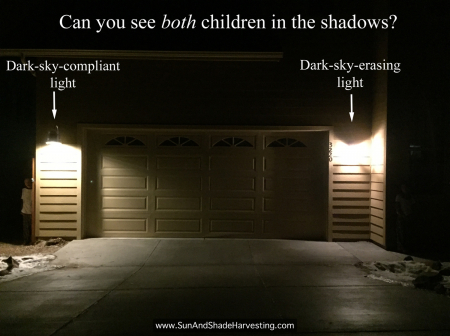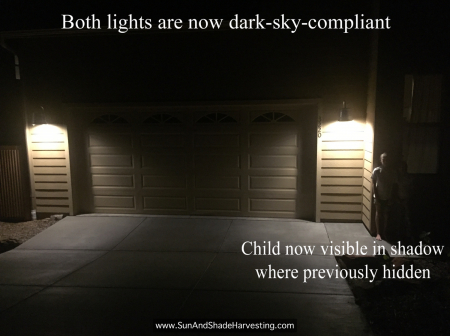Night-Sky Harvesting
by Brad Lancaster
www.SunAndShadeHarvesting.com
Where are we? There is so much light we cannot see.
According to NPR, nearly 80 percent of people in North America cannot see the Milky Way in the night sky due to light pollution.
I love seeing the stars at night. It reminds me of where we are in the universe. It reminds me that we live on a planet. The night sky in its full glory is an open door to the infinite and to wonder.
The stars also enable me to find my way. I use the Big Dipper, Little Dipper, Cassiopeia, or the constellation Orion—or all of them together—to find the north star, and thus the direction north. In the southern hemisphere I use Orion and the Southern Cross constellation to find north and south. (See appendix 7 of my book Rainwater Harvesting for Drylands and Beyond, Volume 1, 2nd edition, for how to use constellations and our sun to find direction.)
I relish the different stories and myths told by diverse cultures about how the various constellations came to be, and how those stories can guide us in life on the ground. The constellations even act as calendars (e.g., in the Sonoran Desert when Pleiades appears on the eastern horizon at dawn, it is time to harvest saguaro fruit1) and timepieces.
But I don’t want to have to leave my neighborhood to see the stars, and as a kid in the suburbs on the north side of Tucson, Arizona, I did not have too. I now live on the north side of downtown Tucson, where light pollution is extreme, but I’m taking action to reduce that light pollution while making the neighborhood safer.
I start at home
I got rid of the outdoor porch lights that shined light in all directions. The damn things would blind me from the glare, allowing my brother Rodd to easily hide from me in the shadows then jump me. He got me every time.
I replaced the old lights with dark-sky-compliant lighting that shines all direct light downward, dramatically reducing blinding glare. Thus, with the new lighting in place, my brother (and all others) could no longer surprise me.
Initially I bought dark-sky compliant light fixtures. Later, I made my own fixtures out of buckets and salvaged chicken-watering cans.
See here for how you can make your own dark-sky-compliant bucket light.
Then the neighbors, friends, and family
I could see so much better I next worked with my neighbors by offering to change all their heavy light-pollution-emitting front-porch light fixtures with dark-sky compliant replacements. Within a month, all front porch lights on my block had been changed. We could see better on the ground, we were not blinded by the porch lights when visiting each other after sunset, we no longer needed to close curtains to make our rooms dark at night, and we could see somewhat better when we looked up at the night sky.
Working on policy level
Parking-lot lights and security lights were still a problem in our neighborhood, along with, in some areas, streetlights. One developer blanketed three blocks of neighboring properties with orange light from security lights that shine outward into the neighborhood from his three-story Sahara Apartments building. This apparently did little if anything to deter crime as a month later, in all that light, someone broke the windows of most of the cars parked on the street. Streetlights were installed in other parts of the neighborhood at intersections where there were crime concerns. After their installation, I observed a dramatic increase in people conducting drug deals and soliciting prostitutes under the lights. I suppose it was easier to see the money and goods.
See here for studies showing how increasing lighting has not been found to reduce crime, and how such lighting can even increase crime.
Neighbors and I fought the proposed installation of streetlights on our blocks, and largely won. To fight crime, we got to know one another better and directed our eyes outward. We looked out for one another, and spent more time on our front porches socializing, reading, and greeting those who walked by. We planted native food-bearing street trees, made walking paths, and installed traffic-calming strategies in the streets to encourage more beneficial street life and interaction. And we called each other and the police if we saw any crime take place. But we had no success getting rid of or deflecting the lights from the student apartments because they were legal under city lighting policy. What was needed was a dark-sky lighting ordinance. Turns out Tucson has one, but in my view it needs to be updated (especially on commercial property) and better enforced.
I saw great success with this in Eagle Mountain, Utah, where mayor Chris Pengra and council implemented an effective dark-sky lighting ordinance in 2014, thanks to which the Milky Way is still visible in the middle of town. Driving through a residential tract-home development at night it was obvious which homes had been built before the ordinance, and which had been built after. I did not want to approach the homes built pre-ordinance due to the painful glare of their seemingly prison-yard-like outdoor lights compared to the very welcoming subdued and romantic outdoor lighting of the post-ordinance homes.
Seeing more
In the subtle light I can see more. This was made delightfully clear when I spent time earlier this year with the great people of the Muonde Trust in rural villages of Zimbabwe where electricity and therefore artificial lighting are minimal (usually just a single solar panel with two car batteries per household to power a couple of indoor lights, a laptop, cell phones, and a stereo). When outside, my eyes did not need to adjust from extreme artificial light to starlight. Thus I could, and did, walk through the villages and forests by starlight alone. Your eyes attune to the low light conditions when that is the norm, and you see well. It was so beautiful and peaceful I became addicted to these nightly walks.
But best of all was the brilliant night sky. Every day we would be working all day long—sharing, teaching, and learning various water-harvesting, fertility-harvesting, and community-building endeavors—and we would return to the village exhausted well after dark. But our energy and spirits were immediately renewed when we brought our chairs outside to sit looking up into the night sky, the Milky Way, and distant galaxies. So beautiful, so enlivening! The endless stars were always a source of renewal. And after connecting so deeply with people throughout the day, it was a delight to connect so deeply with this Place at night.
Is your interest in night-sky harvesting piqued? See here for easy steps you can take to enhance our night skies.
For still more:
- See the International Dark-Sky Association website DarkSky.org
- Listen to the Vanishing Dark episode of the Nocturne podcast
__________
REFERENCES:
1. Stars of the First People: Native American Star Myths and Constellations, by Dorcas S. Miller, Pruett Publishing, 1997, p. 204.
See the new, full-color, revised editions of Brad’s award-winning books
– available a deep discount, direct from Brad:

Volume 1


